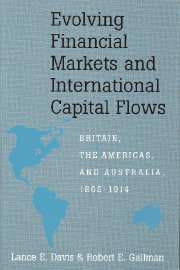 Evolving Financial Markets and International Capital Flows
Evolving Financial Markets and International Capital Flows Book contents
- Frontmatter
- Contents
- 1 Institutional invention and innovation: Foreign capital transfers and the evolution of the domestic capital markets in four frontier countries: Argentina, Australia, Canada, and the United States, 1865–1914
- 2 The United Kingdom
- 3 International capital movements, domestic capital markets, and American economic growth, 1865–1914
- 4 Domestic savings, international capital flows, and the evolution of domestic capital markets: The Canadian experience
- 5 Domestic saving, international capital flows, and the evolution of domestic capital markets: The Australian experience
- 6 Argentine savings, investment, and economic growth before World War I
- 7 Lessons from the past: International financial flows and the evolution of capital markets, Britain and Argentina, Australia, Canada, and the United States before World War I
- 8 Skipping ahead: The evolution of the world's finance markets 1914–1990 – A brief sketch
- 9 Lessons from the past
- Bibliography
- Index
7 - Lessons from the past: International financial flows and the evolution of capital markets, Britain and Argentina, Australia, Canada, and the United States before World War I
Published online by Cambridge University Press: 18 August 2009
- Frontmatter
- Contents
- 1 Institutional invention and innovation: Foreign capital transfers and the evolution of the domestic capital markets in four frontier countries: Argentina, Australia, Canada, and the United States, 1865–1914
- 2 The United Kingdom
- 3 International capital movements, domestic capital markets, and American economic growth, 1865–1914
- 4 Domestic savings, international capital flows, and the evolution of domestic capital markets: The Canadian experience
- 5 Domestic saving, international capital flows, and the evolution of domestic capital markets: The Australian experience
- 6 Argentine savings, investment, and economic growth before World War I
- 7 Lessons from the past: International financial flows and the evolution of capital markets, Britain and Argentina, Australia, Canada, and the United States before World War I
- 8 Skipping ahead: The evolution of the world's finance markets 1914–1990 – A brief sketch
- 9 Lessons from the past
- Bibliography
- Index
Summary
Introduction
Economists have tended to focus their attention on short-run issues in part because the institutional structure – the rules that are observed or enforced that govern the ways in which economic agents can compete or cooperate – can be treated as exogenous and fixed. Any economist who attempts to understand the process of long-run economic growth and development, however, must immediately confront the problem of institutional change. In the long run the institutional structure does change, and the changes are at least partly endogenous. Any successful long-run analysis must explicitly include assumptions about the nature of institutional development, but we still know little about the relationship between the institutional structure and the more traditional economic variables or about the way changes in the external environment – economic, political, social, and cultural – affect the institutional structure.
Much of what we do know about institutional change comes from the work of Nobel Prize winner Douglass North. To North, “the economies of scope, complementarities, and network externalities of an institutional matrix make institutional change overwhelmingly incremental and path dependent.” Since “the static nature of economic theory ill fits us to understand that process we need to construct a theoretical framework that models economic change.” Although he clearly understands the nature of the problem, we are left with a warning, an admonishment, and a number of examples.
- Type
- Chapter
- Information
- Evolving Financial Markets and International Capital FlowsBritain, the Americas, and Australia, 1865–1914, pp. 753 - 838Publisher: Cambridge University PressPrint publication year: 2001


